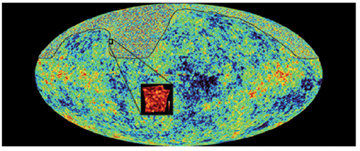Are you a journalist? Please sign up here for our press releases
Subscribe to our monthly newsletter:
May God bless and keep you always
May your wishes all come true
May you always do for others
And let others do for you.
May you build a ladder to the stars
And climb on every rung
May you stay forever young
Forever young, forever young
May you stay forever young.
-- Forever Young. Music and lyrics: Bob Dylan

Will the universe - born, according to the widely accepted theory, some 15 billion years ago in the Big Bang - end with a whimper? Prof. Shaul Hanany, currently of the University of Minnesota and soon to join Weizmann’s Particle Physics Department, hopes to shed light on this question by measuring cosmic microwave background radiation, a relic from the Big Bang.
According to the Big Bang theory, the entire visible universe, including all its matter and energy, once occupied a tiny, extremely hot and dense region. At some stage, and for a yet unknown reason, this region began to expand - voila: the Big Bang. During this expansion, matter dispersed in all directions and resembled a thick primordial soup.
But how, ask cosmologists, did the current structure of the universe emerge from this primordial soup? Had the original soup been entirely uniform, clumps of matter such as the galaxies would not have formed; today’s universe would still be a continuous, uniform soup, with no galaxies, stars or, of course, humans probing its nature.
The existence of distinct clumps of matter has led cosmologists to hypothesize that different areas of the primordial soup were indeed distinguished from one another by minute variations in density, much like ripples or wrinkles. With time, and under the influence of gravity, these wrinkles intensified, causing the denser areas to give rise to the galaxies and stars known today, while the less dense areas gave rise to enormous empty spaces.
This hypothesis was confirmed in April 1992, when NASA’s satellite COBE succeeded in peeking back in time to when the universe was only 300,000 years old. COBE found tiny variations in the microwave radiation arriving from different locations in the universe - providing support for the notion of differences in the density of ancient matter. The song of these ripples is that of a forever young universe. “In the very young universe, radiation was tied to matter; the two were separated only when matter dispersed and cooled down,” explains Hanany. “However, because of their common past, the differences in radiation measured today still accurately portray density differences in matter and energy way back in time.”
Some of the most precise mappings of cosmic background radiation were obtained in two experiments co-led by Hanany. The results from one of them were subsequently selected as one of the ten most important scientific discoveries of the year 2000 by the editors of Science magazine. Both experiments used research balloons - one was launched in Texas and landed there; the other was launched in Sweden and landed in Siberia.
Analyzing the data from these experiments, Hanany and his colleagues inferred the total density of matter and energy in the universe with unprecedented accuracy - a finding that led to the conclusion that space is flat. Einstein’s equations allow for both flat and curved geometries for our space. Now we know which of those is realized in nature.
Drawing on additional astrophysical data the team also calculated the densities of different types of matter and energy, showing that the “regular” matter with which we are all familiar and from which we are all made - that is, stuff made of protons, neutrons and electrons - constitutes only 5 percent of the entire matter and energy in the universe. The nature of the other 95 percent remains unclear. What we do know is that it consists of two distinct types: “dark matter” and “dark energy.” Although we can’t see the dark matter, we are able to accurately measure its gravitational pull on regular visible matter, which slows down the expansion of the universe. Dark energy, in contrast - which constitutes roughly 65 percent of the stuff in the universe - also can’t be seen, but its gravitational effect is opposite to that of both dark and regular matter. It exerts a negative, or repulsive, force of gravity, thereby speeding up the expansion of the universe.
“The large amount of dark energy tends to accelerate the universe’s rate of expansion,” Hanany says, “thereby widening the distances between galaxies at an ever-increasing rate. If this process continues for several billions of years, Earth and our galaxy, the Milky Way, will be isolated in the expanse of the universe, while all other galaxies will have flown away to enormous distances, completely disappearing from view. The universe will seem dark and bleak.”
Hanany and his colleagues are currently focusing on the polarization of cosmic background radiation, hoping to obtain more information about the universe as it was a split second after the Big Bang. “It will be a fantastic sight - viewing the universe so close to its birth,” he says.
